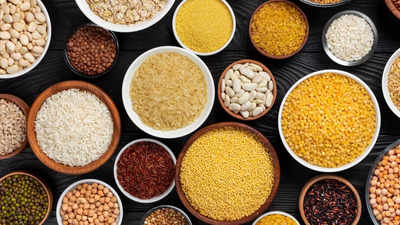Trending
7 Gluten-free grains and cereals that are good for Diabetics
Learn about the importance of choosing the right cereals and grains for managing diabetes. Explore gluten-free options like quinoa, buckwheat, finger millet, brown rice, amaranth, teff, and oats, which are rich in nutrients and help regulate blood sugar levels effectively.

Deciding ‘what to eat’ and ‘what to avoid’ in diabetes is one of the major concerns of people struggling with this lifestyle disorder. While avoiding sugar is a strict no-no, certain foods can also silently spike sugar levels and affect overall health. Well, carbohydrates like flour and cereals can also trigger sugar levels, increase the risk of cardiovascular ailments, lead to obesity, or affect vital organs of the body.
Why these foods?
There’s no denying that people suffering from diabetes need to choose their food wisely to keep sugar levels under control, so we have curated a list of common cereals and grains that are not only packed with nutrients but are also gluten-free, which makes these healthy carbs perfect for diabetics. Read on and try it out.

Gluten-free grains and cereals offer a double benefit—they not only cater to those with gluten sensitivity or celiac disease but are also good for people suffering from high sugar levels. These grains and cereals are complex carbs that are rich in dietary fiber, nutrients, and antioxidants that help in the slow release of sugar into the bloodstream and also help in boosting metabolic health as well as immunity. Here are seven
Quinoa
Quinoa has gained popularity for its high-quality protein content, which contains all nine essential amino acids, making it a valuable addition to a diabetic diet. Quinoa also provides fiber, which aids in blood sugar control and digestive health. It has a low glycemic index (GI), meaning it does not cause sharp rises in blood sugar levels. When cooked with veggies, spices, or low-fat foods, this delight can make for a wholesome meal.

Buckwheat
Buckwheat, also known as Kuttu ka Atta, is not related to wheat and is naturally gluten-free. Buckwheat groats are the hulled seeds of the buckwheat plant, and its flour can be used in various dishes, including porridge, salads, roti, poori, and whatnot! Rich in nutrients and fiber, consuming buckwheat can slow down the release of glucose into the bloodstream, helping to maintain steady blood sugar levels. It also contains beneficial antioxidants like Rutin, which may have cardiovascular benefits.
Finger Millet
Ragi, also known as finger millet, is a nutrient-rich grain, which is perfect for people struggling with diabetes and following a simple gluten-free diet. Low in glycemic index, this millet helps in steady
release of glucose into the bloodstream slowly, helping to regulate blood sugar levels. Apart from that, ragi is rich in dietary fiber, which aids digestion, promotes satiety, and is crucial for managing diabetes. Adding ragi to your diet is simple and can be cooked as porridge, dosa, pancakes, soup, or baked goods.

Brown Rice
Brown rice is a whole grain that retains its outer bran layer, which is rich in fiber and nutrients. It has a lower GI compared to white rice because it contains more fiber and nutrients that slow down the digestion and absorption of carbohydrates. Brown rice provides complex carbohydrates essential for sustained energy levels and contains vitamins and minerals like B vitamins, magnesium, and selenium.
Amaranth
Amaranth is an ancient grain that is naturally gluten-free and has a nutty flavor. It is rich in protein, fiber, and micronutrients such as iron and calcium. Amaranth has a low GI, helping to stabilize blood sugar levels after meals. It can be cooked similarly to rice or quinoa and used in salads, porridge, or baked goods.
Teff
Teff is a tiny grain native to Ethiopia and Eritrea known for its high nutritional value. It is gluten-free and packed with protein, fiber, and minerals such as iron and calcium. Teff has a low GI, making it beneficial for managing blood sugar levels. It is commonly used to make injera, a traditional Ethiopian flatbread, but can also be cooked as porridge or used as a gluten-free flour in baking.
Read more: 7 Low calorie delights made with Oats
Oats
Oats are naturally gluten-free and are a great option for individuals with diabetes, celiac disease, or gluten sensitivity. Choosing gluten-free oats is essential. Oats are rich in soluble fiber, particularly beta-glucan, which helps to lower cholesterol levels and improve blood sugar control. They have a moderate GI and provide sustained energy, making them a great breakfast option for diabetics.
Why these foods?
There’s no denying that people suffering from diabetes need to choose their food wisely to keep sugar levels under control, so we have curated a list of common cereals and grains that are not only packed with nutrients but are also gluten-free, which makes these healthy carbs perfect for diabetics. Read on and try it out.

Why gluten-free?
Gluten-free grains and cereals offer a double benefit—they not only cater to those with gluten sensitivity or celiac disease but are also good for people suffering from high sugar levels. These grains and cereals are complex carbs that are rich in dietary fiber, nutrients, and antioxidants that help in the slow release of sugar into the bloodstream and also help in boosting metabolic health as well as immunity. Here are seven
diabetic-friendly grains and cereals that are gluten-free and worth trying.
Quinoa
Quinoa has gained popularity for its high-quality protein content, which contains all nine essential amino acids, making it a valuable addition to a diabetic diet. Quinoa also provides fiber, which aids in blood sugar control and digestive health. It has a low glycemic index (GI), meaning it does not cause sharp rises in blood sugar levels. When cooked with veggies, spices, or low-fat foods, this delight can make for a wholesome meal.

Buckwheat
Buckwheat, also known as Kuttu ka Atta, is not related to wheat and is naturally gluten-free. Buckwheat groats are the hulled seeds of the buckwheat plant, and its flour can be used in various dishes, including porridge, salads, roti, poori, and whatnot! Rich in nutrients and fiber, consuming buckwheat can slow down the release of glucose into the bloodstream, helping to maintain steady blood sugar levels. It also contains beneficial antioxidants like Rutin, which may have cardiovascular benefits.
Finger Millet
Ragi, also known as finger millet, is a nutrient-rich grain, which is perfect for people struggling with diabetes and following a simple gluten-free diet. Low in glycemic index, this millet helps in steady
release of glucose into the bloodstream slowly, helping to regulate blood sugar levels. Apart from that, ragi is rich in dietary fiber, which aids digestion, promotes satiety, and is crucial for managing diabetes. Adding ragi to your diet is simple and can be cooked as porridge, dosa, pancakes, soup, or baked goods.

Brown Rice
Brown rice is a whole grain that retains its outer bran layer, which is rich in fiber and nutrients. It has a lower GI compared to white rice because it contains more fiber and nutrients that slow down the digestion and absorption of carbohydrates. Brown rice provides complex carbohydrates essential for sustained energy levels and contains vitamins and minerals like B vitamins, magnesium, and selenium.
Amaranth
Amaranth is an ancient grain that is naturally gluten-free and has a nutty flavor. It is rich in protein, fiber, and micronutrients such as iron and calcium. Amaranth has a low GI, helping to stabilize blood sugar levels after meals. It can be cooked similarly to rice or quinoa and used in salads, porridge, or baked goods.
Teff
Teff is a tiny grain native to Ethiopia and Eritrea known for its high nutritional value. It is gluten-free and packed with protein, fiber, and minerals such as iron and calcium. Teff has a low GI, making it beneficial for managing blood sugar levels. It is commonly used to make injera, a traditional Ethiopian flatbread, but can also be cooked as porridge or used as a gluten-free flour in baking.
Read more: 7 Low calorie delights made with Oats
Oats
Oats are naturally gluten-free and are a great option for individuals with diabetes, celiac disease, or gluten sensitivity. Choosing gluten-free oats is essential. Oats are rich in soluble fiber, particularly beta-glucan, which helps to lower cholesterol levels and improve blood sugar control. They have a moderate GI and provide sustained energy, making them a great breakfast option for diabetics.
End of Article
FOLLOW US ON SOCIAL MEDIA









